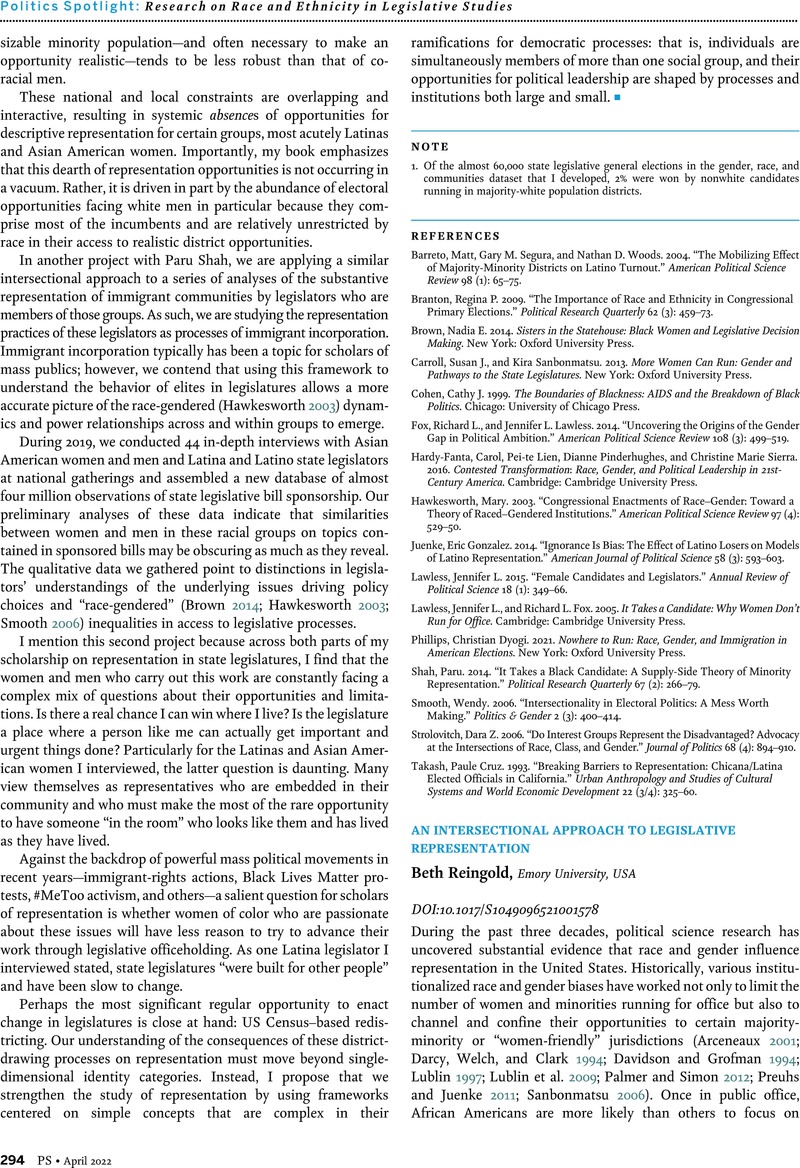No CrossRef data available.
Article contents
An Intersectional Approach to Legislative Representation
Published online by Cambridge University Press: 31 March 2022
Abstract
An abstract is not available for this content so a preview has been provided. Please use the Get access link above for information on how to access this content.

- Type
- Research on Race and Ethnicity in Legislative Studies
- Information
- Copyright
- © The Author(s), 2022. Published by Cambridge University Press on behalf of the American Political Science Association
References
REFERENCES
Arceneaux, Kevin. 2001. “The ‘Gender Gap’ in State Legislative Representation: New Data to Tackle an Old Question.” Political Research Quarterly 54 (1): 143–60.Google Scholar
Bratton, Kathleen A., and Haynie, Kerry L.. 1999. “Agenda Setting and Legislative Success in State Legislatures: The Effects of Gender and Race.” Journal of Politics 61 (3): 658–79.CrossRefGoogle Scholar
Brown, Nadia E. 2014. Sisters in the Statehouse: Black Women and Legislative Decision Making. New York: Oxford University Press.CrossRefGoogle Scholar
Brown, Nadia, and Banks, Kira Hudson. 2014. “Black Women’s Agenda Setting in the Maryland State Legislature.” Journal of African American Studies 18:164–80.CrossRefGoogle Scholar
Canon, David T. 1999. Race, Redistricting, and Representation: The Unintended Consequences of Black-Majority Districts. Chicago: University of Chicago Press.CrossRefGoogle Scholar
Carbado, Devon W., Crenshaw, Kimberlé Williams, Mays, Vickie M., and Tomlinson, Barbara. 2013. “Intersectionality: Mapping the Movements of a Theory.” Du Bois Review 10 (2): 303–12.CrossRefGoogle ScholarPubMed
Casellas, Jason P. 2011. Latino Representation in State Houses and Congress. New York: Cambridge University Press.Google Scholar
Crenshaw, Kimberlé. 1989. “Demarginalizing the Intersection of Race and Sex: A Black Feminist Critique of Antidiscrimination Doctrine, Feminist Theory, and Antiracist Politics.” University of Chicago Legal Forum 139:139–67.Google Scholar
Darcy, R., Welch, Susan, and Clark, Janet. 1994. Women, Elections, and Representation, 2nd edition. Lincoln: University of Nebraska Press.Google Scholar
Davidson, Chandler, and Grofman, Bernard (eds.). 1994. Quiet Revolution in the South: The Impact of the Voting Rights Act, 1965–1990. Princeton, NJ: Princeton University Press.Google Scholar
Davis, Kathy. 2008. “Intersectionality as Buzzword: A Sociology of Science Perspective on What Makes a Feminist Theory Successful.” Feminist Theory 9 (1): 67–85.CrossRefGoogle Scholar
Fraga, Lius Ricardo, Martinez-Ebers, Valerie, Lopez, Linda, and Ramírez, Ricardo. 2008. “Representing Gender and Ethnicity: Strategic Intersectionality.” In Legislative Women: Getting Elected, Getting Ahead, ed. Reingold, Beth, 157–74. Boulder, CO: Lynne Rienner.Google Scholar
Griffin, John. D., and Newman, Brian. 2008. Minority Report: Evaluating Political Equality in America. Chicago: University of Chicago Press.CrossRefGoogle Scholar
Grose, Christian R. 2011. Congress in Black and White: Race and Representation in Washington and at Home. New York: Cambridge University Press.CrossRefGoogle Scholar
Hardy-Fanta, Carol, Lien, Pei-te, Pinderhughes, Dianne M., and Sierra, Christine Marie. 2016. Contested Transformation: Race, Gender, and Political Leadership in 21st-Century America. New York: Cambridge University Press.CrossRefGoogle Scholar
Hawkesworth, Mary E. 2003. “Congressional Enactments of Race-Gender: Toward a Theory of Raced-Gendered Institutions.” American Political Science Review 97 (4): 529–50.CrossRefGoogle Scholar
Haynie, Kerry L. 2001. African American Legislators in the American States. New York: Columbia University Press.CrossRefGoogle Scholar
Lublin, David. 1997. The Paradox of Representation: Racial Gerrymandering and Minority Interests in Congress. Princeton, NJ: Princeton University Press.CrossRefGoogle Scholar
Lublin, David, Brunell, Thomas L., Grofman, Bernard, and Handley, Lisa. 2009. “Has the Voting Rights Act Outlived Its Usefulness? In a Word, ‘No.’” Legislative Studies Quarterly 34 (4): 525–53.CrossRefGoogle Scholar
May, Vivian M. 2015. Pursuing Intersectionality, Unsettling Dominant Imaginaries. New York: Routledge.CrossRefGoogle Scholar
McCall, Leslie. 2005. “The Complexity of Intersectionality.” Signs: Journal of Women in Culture and Society 30 (3): 1771–800.CrossRefGoogle Scholar
Minta, Michael D. 2011. Oversight: Representing the Interests of Blacks and Latinos in Congress. Princeton, NJ: Princeton University Press.Google Scholar
Minta, Michael D., and Brown, Nadia E.. 2014. “Intersecting Interests: Gender, Race, and Congressional Attention to Women’s Issues.” Du Bois Review 11 (2): 253–72.CrossRefGoogle Scholar
Osborn, Tracy L. 2012. How Women Represent Women: Political Parties, Gender, and Representation in the State Legislatures. New York: Oxford University Press.CrossRefGoogle Scholar
Palmer, Barbara, and Simon, Dennis. 2012. Women and Congressional Elections: A Century of Change. Boulder, CO: Lynne Rienner.Google Scholar
Pitkin, Hanna. 1967. The Concept of Representation. Berkeley: University of California Press.CrossRefGoogle Scholar
Preuhs, Robert R., and Juenke, Eric Gonzalez. 2011. “Latino U.S. State Legislators in the 1990s: Majority-Minority Districts, Minority Incorporation, and Institutional Position.” State Politics & Policy Quarterly 11 (1): 48–75.CrossRefGoogle Scholar
Reingold, Beth. 2000. Representing Women: Sex, Gender and Legislative Behavior in Arizona and California. Chapel Hill: University of North Carolina Press.Google Scholar
Reingold, Beth. 2008. “Women as Office Holders: Linking Descriptive and Substantive Representation.” In Political Women and American Democracy, ed. Wolbrecht, Christina, Beckwith, Karen, and Baldez, Lisa, 128–47. New York: Cambridge University Press.CrossRefGoogle Scholar
Reingold, Beth, Haynie, Kerry L., and Widner, Kirsten. 2021. Race, Gender, and Political Representation: Toward a More Intersectional Approach. New York: Oxford University Press.Google Scholar
Rouse, Stella M. 2013. Latinos in the Legislative Process: Interests and Influence. New York: Cambridge University Press.CrossRefGoogle Scholar
Sanbonmatsu, Kira. 2006. Where Women Run: Gender and Party in the American States. Ann Arbor: University of Michigan Press.CrossRefGoogle Scholar
Smooth, Wendy. 2006. “Intersectionality in Electoral Politics: A Mess Worth Making.” Politics & Gender 2 (3): 400–414.Google Scholar
Smooth, Wendy. 2011. “Standing for Women? Which Women? The Substantive Representation of Women’s Interests and the Research Imperative of Intersectionality.” Politics & Gender 7 (3): 436–41.CrossRefGoogle Scholar
Strolovitch, Dara Z. 2007. Affirmative Advocacy: Race, Class, and Gender in Interest-Group Politics. Chicago: University of Chicago Press.CrossRefGoogle Scholar
Swers, Michele L. 2002. The Difference Women Make: The Policy Impact of Women in Congress. Chicago: University of Chicago Press.CrossRefGoogle Scholar
Swers, Michele L. 2013. Women in the Club: Gender and Policy Making in the Senate. Chicago: University of Chicago Press.CrossRefGoogle Scholar
Wilson, Walter Clark. 2017. From Inclusion to Influence: Latino Representation in Congress and Latino Political Incorporation in America. Ann Arbor: University of Michigan Press.CrossRefGoogle Scholar




